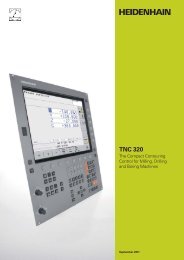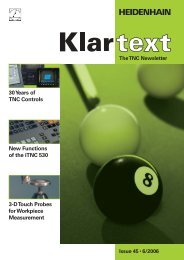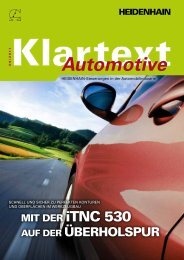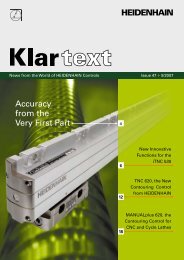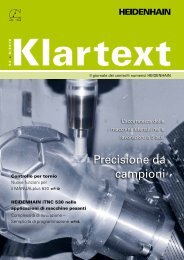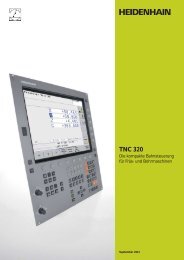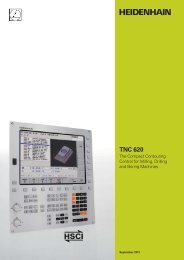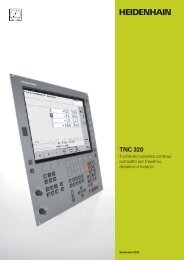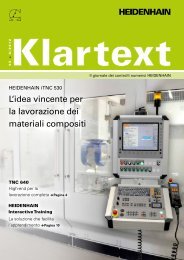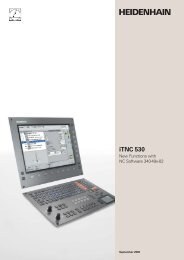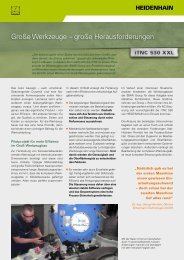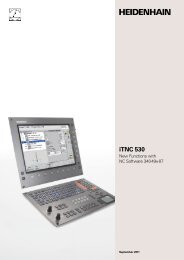iTNC 530 - TNC 640 - DR. JOHANNES HEIDENHAIN GmbH
iTNC 530 - TNC 640 - DR. JOHANNES HEIDENHAIN GmbH
iTNC 530 - TNC 640 - DR. JOHANNES HEIDENHAIN GmbH
You also want an ePaper? Increase the reach of your titles
YUMPU automatically turns print PDFs into web optimized ePapers that Google loves.
Programming in the Workshop<br />
– Straightforward Function Keys for Complex Contours<br />
Programming 2-D Contours<br />
Two-dimensional contours are the bread<br />
and butter of the modern machine shop.<br />
Here the <strong>i<strong>TNC</strong></strong> <strong>530</strong> offers a variety of<br />
possibilities.<br />
Programming with path function keys<br />
If contours are dimensioned for NC, which<br />
means that the end points are specifi ed in<br />
Cartesian or polar coordinates, then you<br />
can program them directly with the path<br />
function keys.<br />
30<br />
Straight and circular contour elements<br />
To program a line segment, for example,<br />
simply press the key for linear traverse. The<br />
<strong>i<strong>TNC</strong></strong> <strong>530</strong> asks for all information required<br />
for a complete programming block, such as<br />
target coordinates, feed rate, cutter radius<br />
compensation and machine functions.<br />
Appropriate path function keys for circular<br />
movement, chamfers, and corner rounding<br />
simplify your programming. To avoid<br />
surface blemishes during approach or<br />
departure from the contour, it must be<br />
approached smoothly—that is, tangentially.<br />
CT<br />
Circular path defi ned<br />
by its end point, with<br />
a smooth (tangential)<br />
departure from the<br />
previous contour<br />
element<br />
CC<br />
CR<br />
C<br />
Circular path defi ned<br />
by its center point,<br />
end point, and<br />
rotational direction<br />
Circular path defi ned<br />
by its radius, end point<br />
and rotational<br />
direction<br />
You simply specify the starting or end point<br />
of the contour and the approaching or<br />
departing radius of the cutter edge—the<br />
control does the rest for you.<br />
The <strong>i<strong>TNC</strong></strong> <strong>530</strong> can look ahead over a radiuscompensated<br />
contour for up to 99 blocks<br />
to watch for back cutting and avoid contour<br />
damage such as can occur when roughing<br />
a contour with a large tool.<br />
Straight line defi ned<br />
by its end point<br />
RND Rounding:<br />
circular path<br />
defi ned by radius and<br />
corner point, with a<br />
smooth (tangential)<br />
transition to its adjoining<br />
contour elements<br />
CHF Chamfer:<br />
defi ned by the<br />
corner point and the<br />
chamfer length



